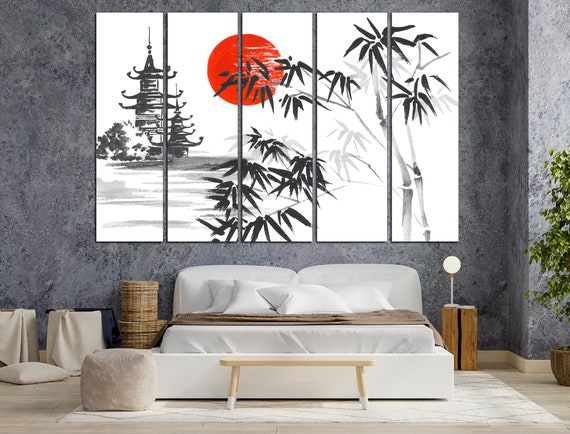Japanese wall decoration is more than just aesthetics; it embodies a philosophy that emphasizes simplicity, nature, and tranquility. Whether you live in a traditional Japanese home or a modern apartment, incorporating elements of Japanese design can create a serene atmosphere that feels both inviting and refreshing. In this comprehensive guide, I’ll share my personal experiences, insights, and valuable tips to help you master the art of Japanese wall decoration.
The Essence of Japanese Wall Decoration
Japanese wall decoration reflects the harmony that exists between humans and nature. From minimalist designs to rich cultural symbols, the primary goal is to promote peace and simplicity. Traditional techniques and modern interpretations blend beautifully, allowing anyone to adopt this style, regardless of their space or budget.
Understanding Japanese Aesthetics
Before diving into specific decoration ideas, let’s take a closer look at the core principles of Japanese aesthetics:

- Wabi-sabi: The beauty of imperfection and transience.
- Ma: The concept of negative space, emphasizing simplicity and balance.
- Shibui: The understated elegance that comes from minimalism.
Popular Styles of Japanese Wall Decoration

Here’s a breakdown of the most popular styles to inspire your decorating journey:
1. Traditional Japanese Style

This style revolves around elements such as shoji screens, tatami mats, and natural materials. Traditional wall decorations may include:
- Calligraphy: Beautifully written sayings and poetry.
- Scrolls: Hangings featuring art or messages.
- Ink Wash Paintings: Featuring landscapes or serene scenes.

2. Modern Japanese Style
Modern interpretations of Japanese design often incorporate sleek lines and contemporary materials, such as:

- Wall Panels: Using wood or MDF with minimalist patterns.
- Metal Accents: Incorporating artworks or sculptures.
- Textured Finishes: Like plaster treatments that mimic natural elements.
3. Zen-Inspired Decor

Zen decor focuses on creating a peaceful and meditative environment. Delight in:
- Nature Scenes: Large-scale murals or prints of serene landscapes.
- Indoor Plants: Use plants to bring life and calmness to walls.
- Water Features: Consider wall-mounted water elements for a soothing sound.
Essential Elements for Japanese Wall Decoration
To effectively decorate your walls in a Japanese style, consider these essential elements:
Materials
Stick to natural materials as much as possible:
- Bamboo: Great for frames or wall panels.
- Wood: For shelves, panels, or accent walls.
- Paper: Shoji screens or washi paper art.
Colors
A calming palette is ideal. Think:
- Neutral Tones: Whites, creams, and light browns.
- Earthy Colors: Olive green, terracotta, and muted blues.
- Accent Colors: Use reds or blues sparingly to highlight certain features.
Lighting
Lighting sets the mood:
- Natural Light: Maximize with uncovered windows.
- Soft Lamps: Use paper lanterns for a warm glow.
- Wall Sconces: Add architectural interest and illumination.
DIY Japanese Wall Decoration Ideas
Let’s get creative! Here are some DIY projects you can undertake to enrich your space with Japanese wall decor:
1. Create a Shoji Screen
A shoji screen can divide space and serve as a stunning backdrop. You can build one using a simple wooden frame and translucent paper:
- Materials Needed: Wooden slats, shoji paper, wood glue, and a saw.
- Steps: Cut the wood, assemble the frame, glue the paper, and enjoy the elegance!
2. DIY Wall Art Using Washi Tape
Washi tape allows for easy creativity. You can create patterns or images with ease:
- Choose a Template: Find inspiration online or draw your own.
- Start Taping: Follow your design closely, ensuring to use different colors and patterns.
3. Nature-Inspired Murals
Paint a serene landscape mural:
- Find a Design: Options include cherry blossoms, bamboo, or mountains.
- Use A Soft Color Palette: Stick to calming colors for a tranquil effect.
Comparison Table: Traditional vs. Modern Japanese Wall Decoration
| Feature | Traditional Japanese Decor | Modern Japanese Decor |
|---|---|---|
| Materials | Natural, hand-crafted materials | Contemporary, sleek materials |
| Color Palette | Earthy and muted tones | Bold hues with minimalism |
| Design Focus | Complex and ornamental | Simplicity and functionality |
| Art Elements | Nature-inspired or spiritual | Abstract and geometric |
Pros and Cons of Japanese Wall Decoration
Pros
- Promotes a tranquil atmosphere.
- Encourages creativity and self-expression.
- Incorporates sustainable and natural materials.
Cons
- May require cultural understanding for authenticity.
- Could be expensive if sourcing traditional materials.
- Maintenance of natural elements can be demanding.
Incorporating Japanese Wall Decoration into Your Home
Now that you have a solid understanding of Japanese wall decoration, let’s discuss how to seamlessly incorporate it into your home:
Living Room
Create a focal point with a large mural or a hanging scroll that reflects peace. Pair with natural wood furniture and soft textiles.
Bedroom
Consider muted colors and minimal decor. A simple shoji screen can replace a standard closet door for a unique aesthetic.
Office
Incorporate elements of nature, such as mountain landscapes or bamboo prints, to inspire creativity and focus.
FAQs About Japanese Wall Decoration
What are the key characteristics of Japanese wall decoration?
Key characteristics include simplicity, natural materials, muted colors, and a strong connection to nature and culture.
Can I use modern elements in Japanese wall decoration?
Absolutely! Modern touches can blend beautifully with traditional elements to create a unique style that suits your taste.
Is Japanese wall decoration expensive?
The cost can vary significantly. By opting for DIY projects or sourcing materials locally, you can create beautiful decor on a budget.
How can I maintain the beauty of natural materials in my decor?
Regular cleaning and protecting materials from humidity and damage ensures longevity. Use gentle cleaners and avoid harsh chemicals.
Conclusion
Japanese wall decoration offers a unique blend of culture, art, and philosophy that can transform any space into a tranquil retreat. From my own experience, it’s a delightful journey into simplicity and beauty. Start small, get creative, and soon you’ll find that the aesthetic adds value not just to your home, but to your daily life. Happy decorating!